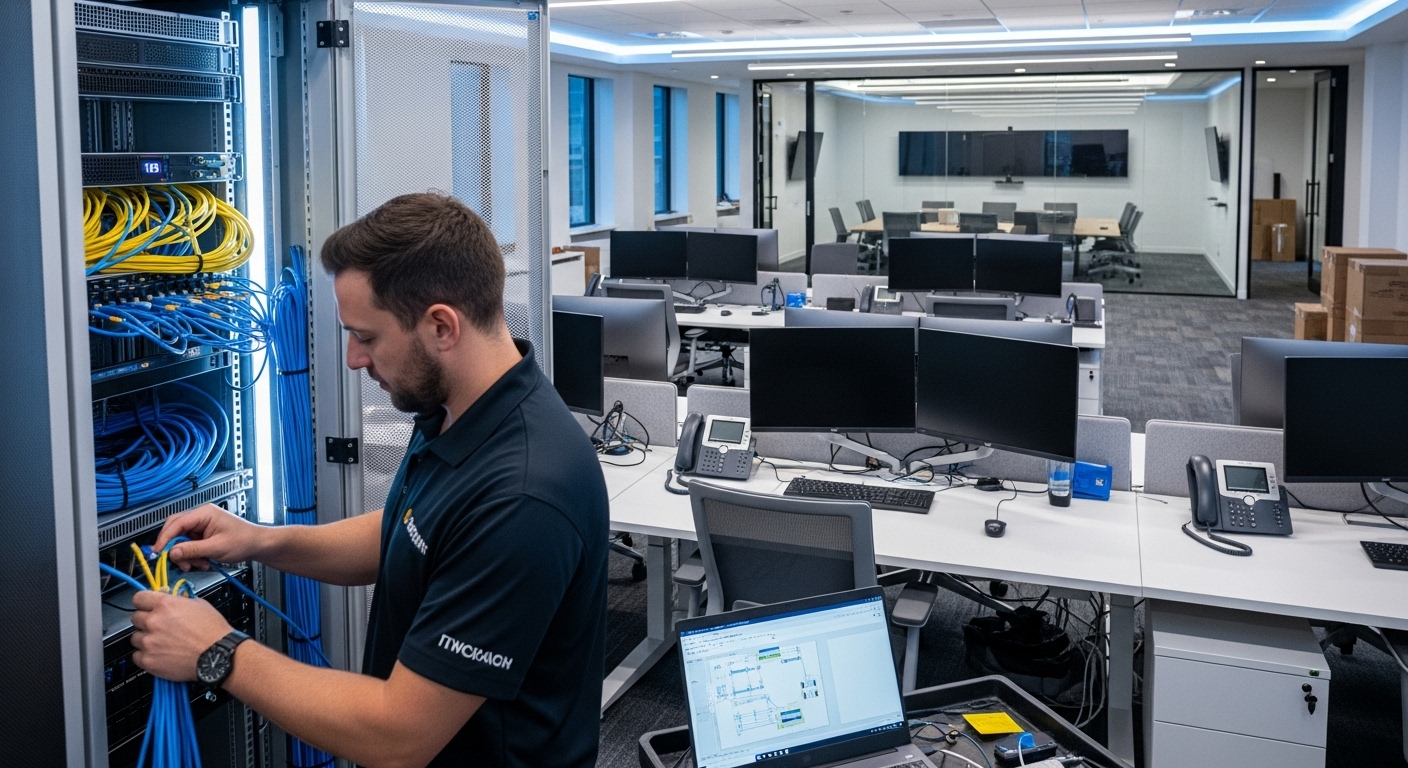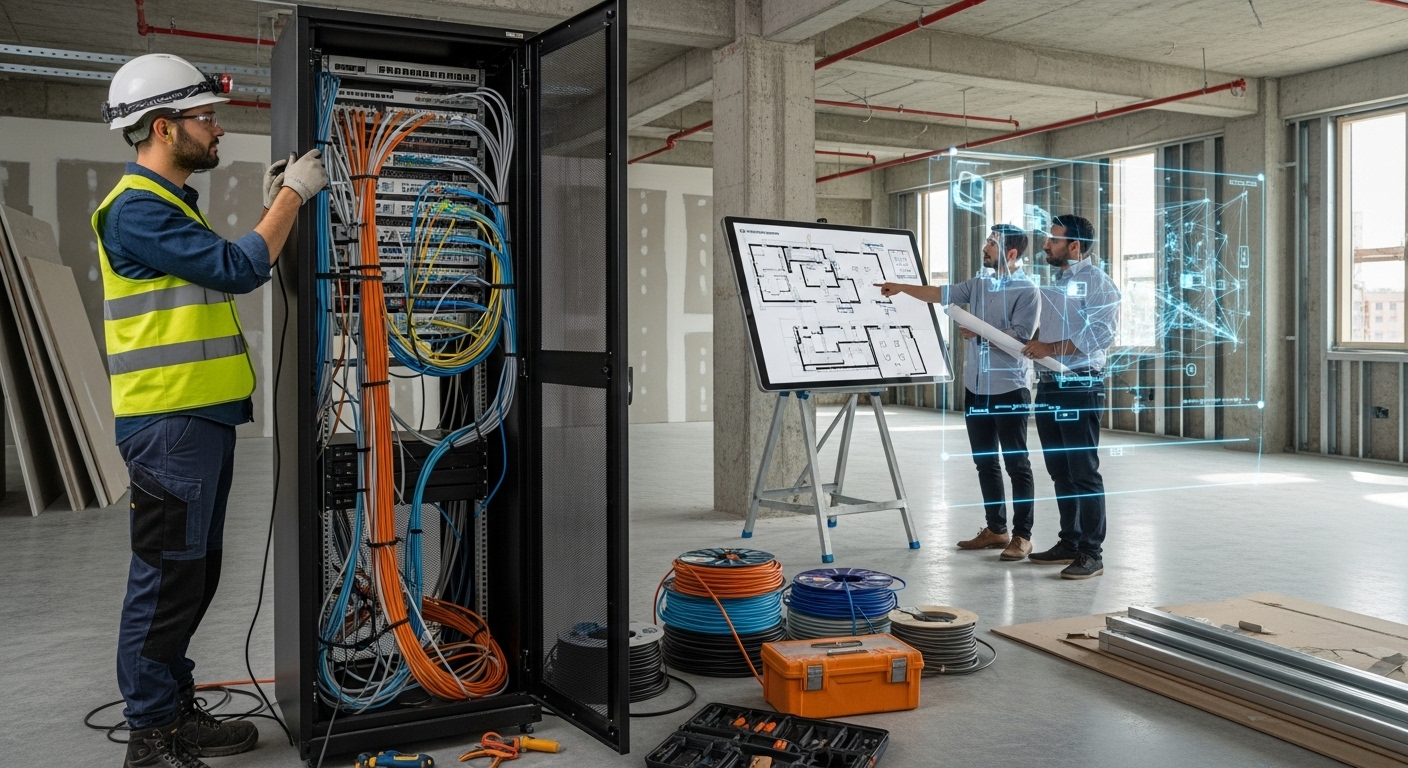In today’s digitally-driven business landscape, the design of a new office is about more than just aesthetics and floor plans; it’s about building a high-performance engine for productivity. At the heart of this engine lies a robust IT infrastructure, seamlessly integrated with the physical workspace. Moving into a new office presents a unique opportunity to build this digital backbone from the ground up, yet the process is fraught with complexity. A misstep in planning can lead to costly retrofits, operational downtime, and a cascade of logistical nightmares. Recent trends show a move away from siloed planning towards a holistic approach where IT setup, design, and logistics are treated as interconnected disciplines. This guide provides a unified framework, guiding you from the initial floor plan to a flawless operational launch, ensuring your new workspace is ready to meet the demands of your business from day one.
Strategic planning: the digital blueprint
Before a single cable is run or a server is purchased, the foundation for a successful IT setup must be laid through meticulous strategic planning. This initial phase, which should begin at least three to four months before your move-in date, is critical for aligning your technology infrastructure with your core business objectives. Start by conducting a comprehensive needs assessment. This involves more than just counting a headcount; it’s about understanding the specific workflows and technological requirements of different teams. Your engineering team will have vastly different needs from your sales department, from processing power to network access. Consider your company’s growth trajectory for the next three to five years. A scalable infrastructure is not a luxury; it’s a necessity that prevents you from having to undertake a costly and disruptive overhaul just a couple of years down the line. Once needs are defined, establish a detailed budget that accounts for everything: hardware, software licenses, cabling installation, vendor fees, and a contingency for unexpected issues. This digital blueprint becomes the guiding document for all subsequent decisions, ensuring every component serves a strategic purpose and aligns with your financial framework.
Cabling and connectivity: the central nervous system
The structured cabling system is the central nervous system of your office, the invisible infrastructure that powers every digital interaction. During the design phase, integrating the cabling plan with the architectural floor plan is paramount. Work closely with your architects and IT consultants to map out the optimal locations for data ports, server rooms, and wireless access points. A common best practice is to install at least two data ports (using high-quality Cat6 or Cat6a cables) at each workstation to accommodate both a computer and a VoIP phone, providing redundancy and flexibility. The server room or IT closet is the heart of this system and requires special attention. It must be a secure, climate-controlled environment, ideally with a dedicated cooling system to maintain an optimal temperature between 68-71°F (20-22°C). This prevents overheating, which is a primary cause of hardware failure. Furthermore, ensure the room has a reliable power supply, including an uninterruptible power supply (UPS) to protect critical systems from power surges or outages. Thoughtful cable management, using racks, trays, and clear labeling, might seem like a minor detail, but it is essential for simplifying future maintenance, troubleshooting, and upgrades.
Hardware and software: equipping your workforce
With a solid infrastructure plan, you can proceed to the procurement of hardware and software. This stage should be a strategic exercise in standardization and future-proofing. Standardizing on a few models for workstations and laptops simplifies procurement, streamlines IT support, and makes inventory management more efficient. When selecting networking equipment—such as routers, switches, and firewalls—choose business-grade hardware that can handle your projected network traffic and offers robust security features. Beyond the core components, consider the peripherals that facilitate productivity, such as ergonomic monitors, reliable printers, and high-quality conferencing equipment. On the software side, perform a thorough audit of your licensing needs. This is the perfect time to evaluate your subscriptions to productivity suites like Microsoft 365 or Google Workspace and any specialized, business-critical applications. Ensure all software is properly licensed to maintain compliance and avoid legal risks. Engaging with your Internet Service Provider (ISP) and other key technology vendors well in advance is crucial. This proactive communication ensures that your internet circuits and other essential services are installed and activated before your team arrives, preventing a frustrating and unproductive start in the new space.
Network security: building the digital fortress
In an era of escalating cyber threats, integrating security into the foundation of your IT setup is non-negotiable. A proactive, multi-layered security strategy is essential to protect your company’s valuable data and intellectual property. This begins at the network perimeter with the implementation of a powerful firewall to control incoming and outgoing traffic, acting as the first line of defense. Inside the network, deploying robust antivirus and anti-malware solutions across all workstations and servers is critical. However, modern security goes beyond just blocking threats. Implementing strong access control policies, including the enforcement of complex passwords and multi-factor authentication (MFA), significantly reduces the risk of unauthorized access. It’s also wise to segment your network using VLANs, which can isolate sensitive data and limit the potential impact of a breach. Furthermore, a comprehensive data backup and disaster recovery plan is vital. This should involve automated, regular backups of all critical data to a secure offsite or cloud location. By testing this recovery process periodically, you can ensure that your business can get back online quickly in the event of data loss, whether from a hardware failure, natural disaster, or ransomware attack.
Logistics and migration: executing the move
The physical relocation of your IT assets is one of the most delicate phases of the entire process, where meticulous planning meets execution. Success hinges on minimizing downtime and ensuring every piece of equipment arrives safely and is reconnected correctly. Begin by creating a detailed inventory of all IT assets, from servers to individual monitors. Label every component and cable clearly with its designated position in the new office. Before disconnecting any systems, perform a final, comprehensive data backup. For the move itself, consider engaging professional IT movers who specialize in transporting sensitive electronic equipment. They have the expertise and equipment to handle the systematic dismantling, secure packing, and careful reassembly of your infrastructure. Communicate the migration plan clearly to all employees, informing them of the timeline and any expected service interruptions. Once in the new space, the IT team’s role is to systematically reconnect and power up the infrastructure. This should be followed by a rigorous testing phase where every aspect of the system—from internet connectivity and network access to individual software applications—is thoroughly checked to identify and resolve any issues before the full workforce arrives.
Day one and beyond: continuous optimization
The successful launch of your new office is a significant milestone, but it is not the end of the IT setup process. The focus now shifts from implementation to ongoing management and optimization. From the moment your employees walk in, a reliable IT support system must be in place. Whether you have an in-house team or a managed service provider, ensure there is a clear and efficient process for employees to report issues and receive timely assistance. This is crucial for maintaining productivity and morale during the initial transition period. It is also essential to have comprehensive documentation of your entire network setup, including hardware configurations, IP address maps, and software license information. This documentation is invaluable for troubleshooting, future planning, and onboarding new IT staff. Finally, schedule a post-move review with all key stakeholders a few weeks after settling in. This meeting is an opportunity to discuss what went well, what could have been improved, and to document lessons learned. This iterative process of review and optimization ensures that your IT infrastructure not only supports your current business needs but also continues to evolve and adapt, providing a resilient and powerful foundation for future growth.
Ultimately, treating your IT setup as an integrated component of your office design and logistics strategy is the key to a successful launch. By moving beyond a simple checklist and embracing a holistic approach that encompasses strategic planning, robust security, and meticulous execution, you can build a workspace that is more than just a physical location. You create a connected, secure, and highly productive environment that empowers your team and positions your business for sustained success. The investment in careful planning and integration pays dividends long after the last box is unpacked, transforming your IT infrastructure from a mere operational cost into a true strategic asset.





